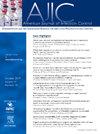Clinical impact of active screening cultures for carbapenem-resistant Acinetobacter baumannii: A systematic review and meta-analysis
IF 3.8
3区 医学
Q2 INFECTIOUS DISEASES
引用次数: 0
Abstract
Background
Carbapenem-resistant Acinetobacter baumannii (CRAB) has emerged as a significant health care-associated infection carrying substantial mortality. We assessed the clinical impact of active screening cultures for CRAB.
Methods
A systematic review and meta-analysis, aiming to answer 2 questions: (1) Does screening versus no screening improve clinical outcomes? (2) Does positive screening (“CRAB carrier”) predict CRAB infections? We searched the literature until January 2024 for comparative studies reporting clinical outcomes (mortality, invasive CRAB infections).
Results
Of 5,407 screened publications, 9 studies (10,865 individuals) were included. Invasive CRAB infection rate was significantly higher among CRAB carriers (OR 11.14, 95% CI 4.95-25.05, with substantial heterogeneity stemming from size rather than direction of the effect). Negative predictive value of noncarriage for invasive infection was 97%. CRAB bloodstream infection rate was significantly higher among carriers (odds ratio 16.23, 95% confidence interval 2.9-110.08). No difference was demonstrated between the groups for CRAB ventilator-associated pneumonia, length of stay, and mortality. Only 1 study reported outcomes for study question #1.
Conclusions
Data to support active CRAB screening are scarce regarding its clinical benefit for patients. Positively screened patients are at significantly higher risk for invasive CRAB infections, with high negative predictive value for noncarriage. This did not translate to reduced mortality.
积极筛选培养以减少耐碳青霉烯类鲍曼不动杆菌引起的感染:系统综述和荟萃分析。
背景:耐碳青霉烯类鲍曼不动杆菌(CRAB)已成为一种严重的医疗相关性感染,可导致大量死亡。我们旨在评估主动筛查培养 CRAB 的临床影响:方法:系统回顾和荟萃分析,旨在回答两个问题:1.筛查与不筛查是否能改善临床结果?2.阳性筛查("CRAB 携带者")是否能预测 CRAB 感染?我们检索了 MEDLINE、Cochrane 图书馆、Web of Science 和会议(截至 2024 年 1 月)上报告临床结果(死亡率、侵入性 CRAB 感染)的比较研究:在筛选出的 5,407 篇出版物中,有 9 项研究(10,865 人)被纳入研究问题 2。CRAB携带者的侵袭性CRAB感染率明显更高(几率比[OR]11.14,95%置信区间[CI]4.95-25.05,大量异质性源于效应的大小而非方向)。非携带者对侵袭性感染的阴性预测值(NPV)为 97%。携带者的 CRAB 血流感染率明显更高(OR 16.23,95% CI 2.9-110.08)。两组 CRAB 呼吸机相关肺炎、住院时间和死亡率无明显差异。只有一项研究报告了筛查与不筛查的结果(研究问题1):结论:关于 CRAB 筛查对患者的临床益处,支持 CRAB 积极筛查的数据很少。筛查呈阳性的患者发生侵袭性 CRAB 感染的风险明显较高,非流产的 NPV 很高。这并没有降低死亡率。
本文章由计算机程序翻译,如有差异,请以英文原文为准。
求助全文
约1分钟内获得全文
求助全文
来源期刊
CiteScore
7.40
自引率
4.10%
发文量
479
审稿时长
24 days
期刊介绍:
AJIC covers key topics and issues in infection control and epidemiology. Infection control professionals, including physicians, nurses, and epidemiologists, rely on AJIC for peer-reviewed articles covering clinical topics as well as original research. As the official publication of the Association for Professionals in Infection Control and Epidemiology (APIC)

 求助内容:
求助内容: 应助结果提醒方式:
应助结果提醒方式:


